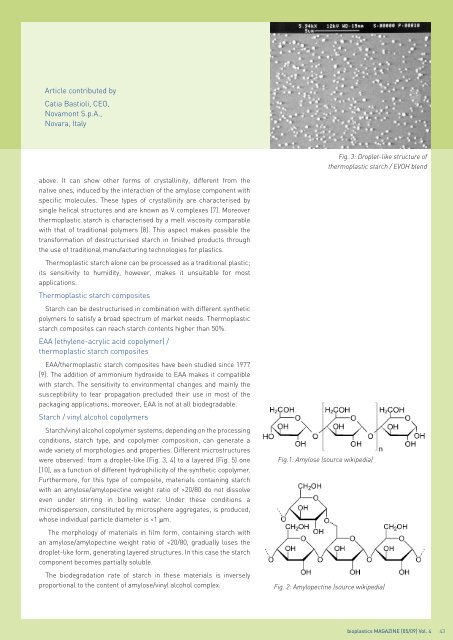bioplasticsMAGAZINE_0905
bioplasticsMAGAZINE_0905
bioplasticsMAGAZINE_0905
You also want an ePaper? Increase the reach of your titles
YUMPU automatically turns print PDFs into web optimized ePapers that Google loves.
Article contributed by<br />
Catia Bastioli, CEO,<br />
Novamont S.p.A.,<br />
Novara, Italy<br />
Fig. 3: Droplet-like structure of<br />
thermoplastic starch / EVOH blend<br />
above. It can show other forms of crystallinity, different from the<br />
native ones, induced by the interaction of the amylose component with<br />
specific molecules. These types of crystallinity are characterised by<br />
single helical structures and are known as V complexes [7]. Moreover<br />
thermoplastic starch is characterised by a melt viscosity comparable<br />
with that of traditional polymers [8]. This aspect makes possible the<br />
transformation of destructurised starch in finished products through<br />
the use of traditional manufacturing technologies for plastics.<br />
Thermoplastic starch alone can be processed as a traditional plastic;<br />
its sensitivity to humidity, however, makes it unsuitable for most<br />
applications.<br />
Thermoplastic starch composites<br />
Starch can be destructurised in combination with different synthetic<br />
polymers to satisfy a broad spectrum of market needs. Thermoplastic<br />
starch composites can reach starch contents higher than 50%.<br />
EAA (ethylene-acrylic acid copolymer) /<br />
thermoplastic starch composites<br />
EAA/thermoplastic starch composites have been studied since 1977<br />
[9]. The addition of ammonium hydroxide to EAA makes it compatible<br />
with starch. The sensitivity to environmental changes and mainly the<br />
susceptibility to tear propagation precluded their use in most of the<br />
packaging applications; moreover, EAA is not at all biodegradable.<br />
Starch / vinyl alcohol copolymers<br />
Starch/vinyl alcohol copolymer systems, depending on the processing<br />
conditions, starch type, and copolymer composition, can generate a<br />
wide variety of morphologies and properties. Different microstructures<br />
were observed: from a droplet-like (Fig. 3, 4) to a layered (Fig. 5) one<br />
[10], as a function of different hydrophilicity of the synthetic copolymer.<br />
Furthermore, for this type of composite, materials containing starch<br />
with an amylose/amylopectine weight ratio of >20/80 do not dissolve<br />
even under stirring in boiling water. Under these conditions a<br />
microdispersion, constituted by microsphere aggregates, is produced,<br />
whose individual particle diameter is


















